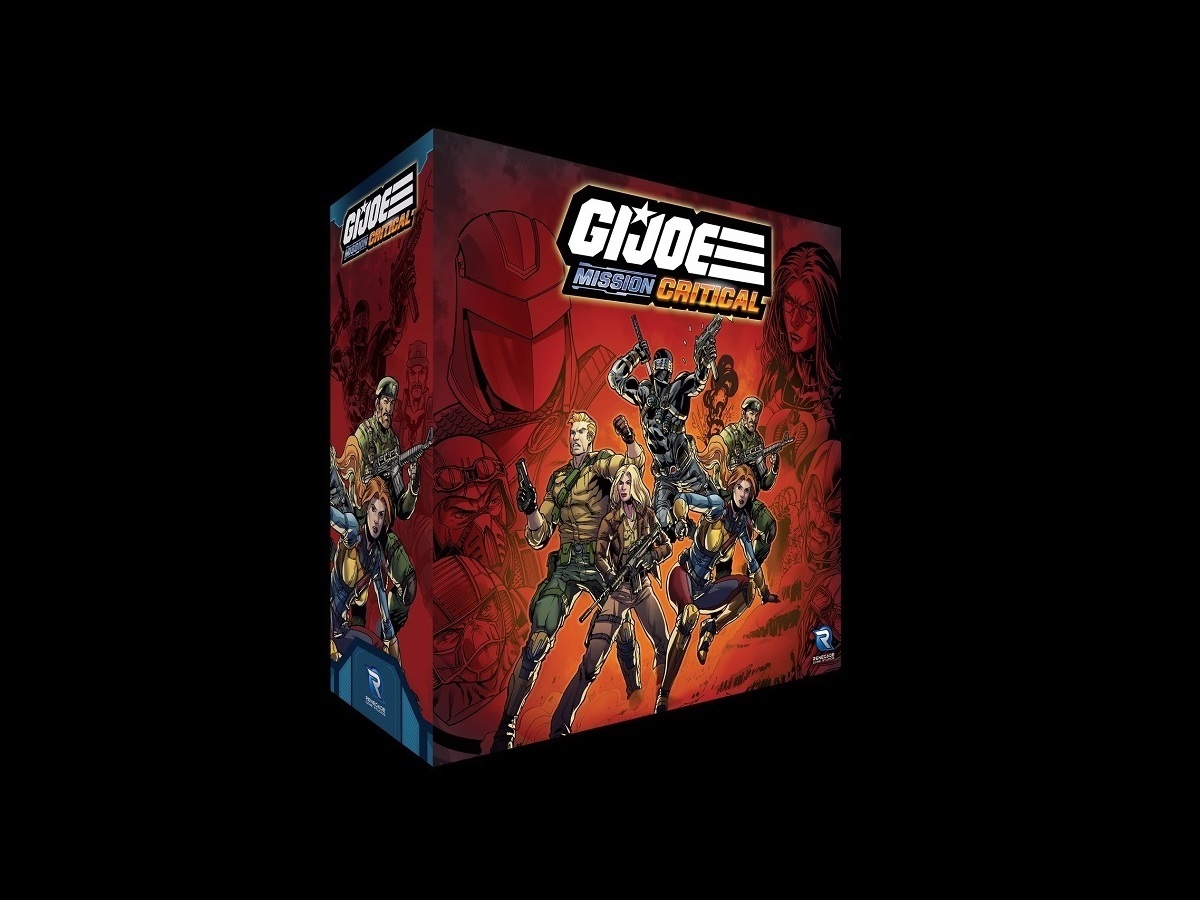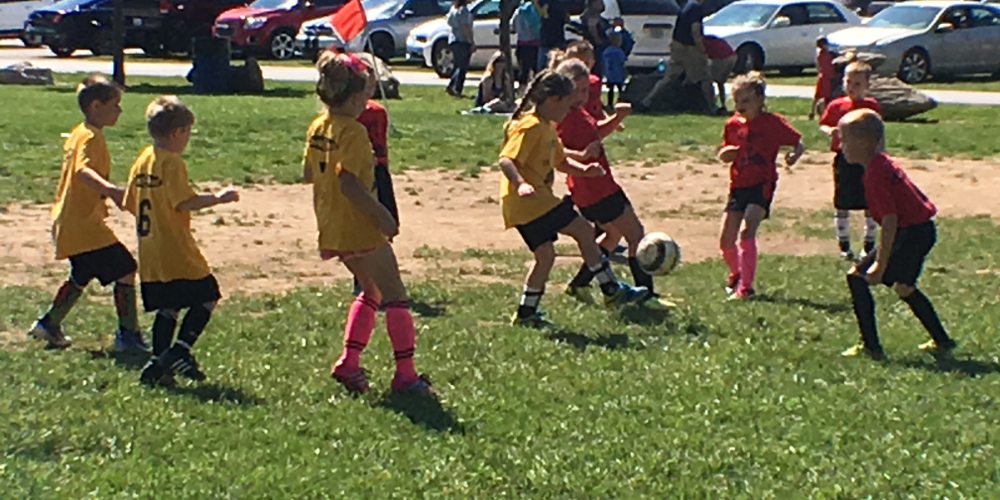A real American hero, G.I. JOE was reintroduced to the world in 1982. Not only was it a popular series of action figures and vehicles, the story was also told through comic books, cartoons, video games, and even a full-length animated movie. While I was just about too old for the action figures, I did enjoy playing with my younger brother and enjoyed the stories in the comic books he collected. I also like how each of the Joes was their own unique character with their won set of skills and abilities. The action figures even came with a dossier file you could cut out from the packaging. It was the story that really sold the products. Now fans of G.I. JOE, whether old or new, can take command of one of the Joes and fight against the evil Cobra Commander as well as his lieutenants and foot soldiers in G.I. JOE: Mission Critical.
What Is G.I. JOE: Mission Critical?
G.I. JOE: Mission Critical is a cooperative table top game for 2-5 players, ages 14 and up, and takes about 45-60 minutes to play. Players take on the roles of Joes and work together to defeat the forces of Cobra before they cause worldwide panic. It’s currently available from your FLGS with a suggest retail price of $120 for a copy of the game. It is also available from the Renegade Games Studios’ Store on Amazon for around $85.
G.I. JOE: Mission Critical was designed by T.C. Petty III and Jonathan Ying and published by Renegade Game Studios, with illustrations by Robert Atkins, Chris Campana, Kyle Petchock, and Marshall Hinson.
G.I. JOE: Mission Critical Components
Here is what you get in the box:
- 5 Joe Figures
- 1 Boss Figure (Cobra Commander)
- 1 Nemesis Figure (Baroness)
- 3 Lieutenant Figures (Dr. Mindbender, Major Bludd, Copperhead)
- 24 Foot Soldier Minis
- 5 Character Cards
- 50 Combat Cards
- 6 Vehicle Cards
- 25 Enemy Deployment Cards
- 60 Enemy Cards
- 5 Location Tiles
- 1 Power Board
- 1 Battle Board
- 1 Lead Hero Token
- 2 Cobra Deployment Tokens
- 2 Bonus Vehicle Tokens
- 12 Action Tokens
- 30 Hit Tokens
- 4 Panic Tokens
- 20 Energy Tokens
- 4 Location Tokens
- 6 Action Dice

Players take on the role of the five Joes representing by these miniatures. The core game comes with Snake Eyes, Scarlett, Duke, Stalker, and Cover Girl. They are used to show where that character is located during the game.
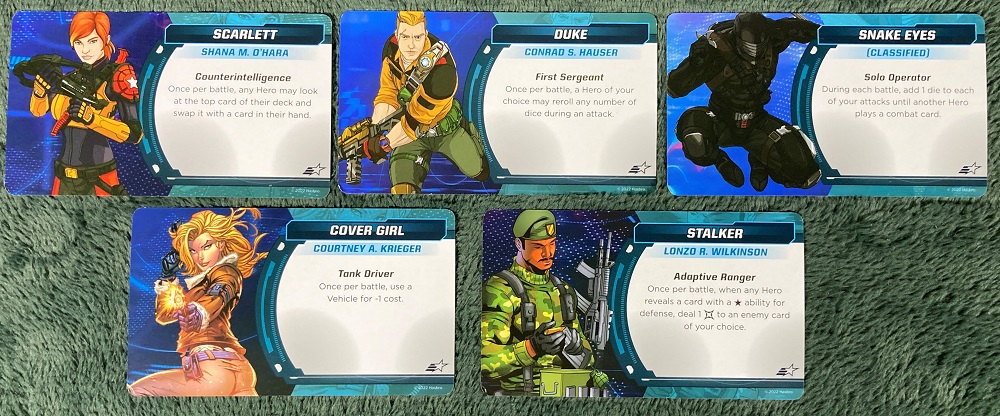
Each of the five Joes have their own character card which contains an illustration of the character as well as that character’s special ability. These abilities reflect that Joe’s play style.

There is a unique deck of 10 combat cards for each of the five Joes. These are all the cards the players get for the entire game and are used during battles. The number at the top left of a card is the energy cost to play this card. The card type and effect text are located below the illustration. The shields at the bottom right indicates how much damage that card can absorb when revealed for defense. Some cards have a star near the shields. This represents a special effect when the card is used for defense. Combat cards come in three types. Attack allow you to inflict damage on enemies. Most of these require rolling the combat dice. Maneuver cards often allow you to gain energy or manipulate cards in your deck, hand, or discard pile. Reaction cards are played in response to something in the game. They can be played out of turn and do not count as a player turn during a battle.
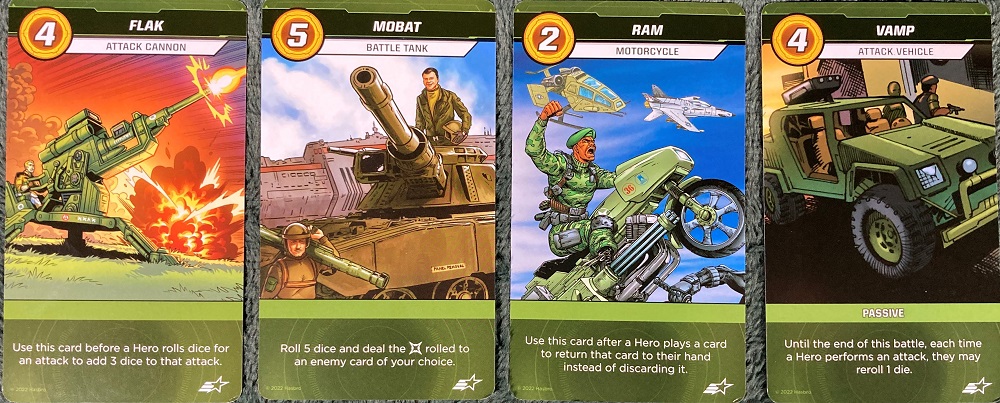
Joes can also bring in vehicles to help them out. The cost is located in the top left corner and the vehicle’s effect is found under the illustration.

Cobra has miniatures for Cobra Commander and his four lieutenants. While a lieutenant, the Baroness is a bit more powerful than the rest and considered a Nemesis. The game also comes with 12 blue Cobra Troopers and 12 red Crimson Guard foot soldier miniatures.

The deployment cards are used to determine the number and types of foot soldiers to deploy as where on the map they deploy. There are also deployment cards for the lieutenants, nemesis, and boss.
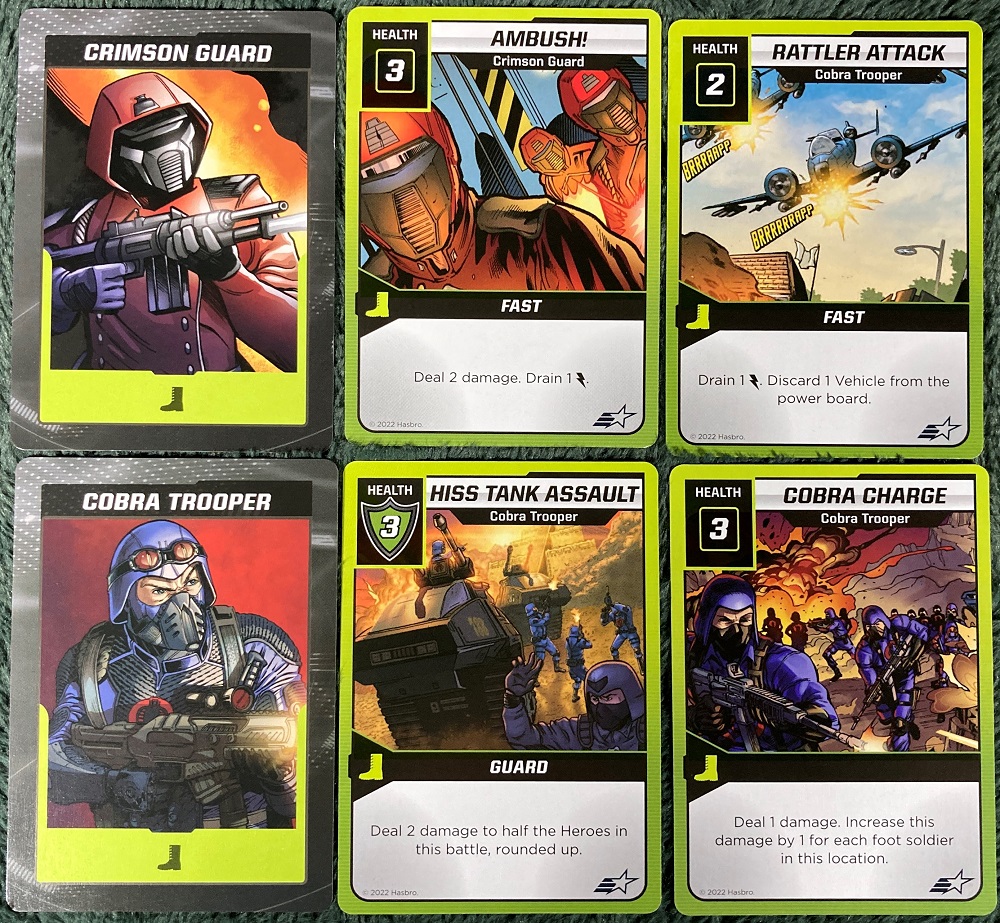
During a battle foot soldier enemy cards are used to attack the Joes. There are separate decks for both the Cobra Troopers and Crimson Guard.
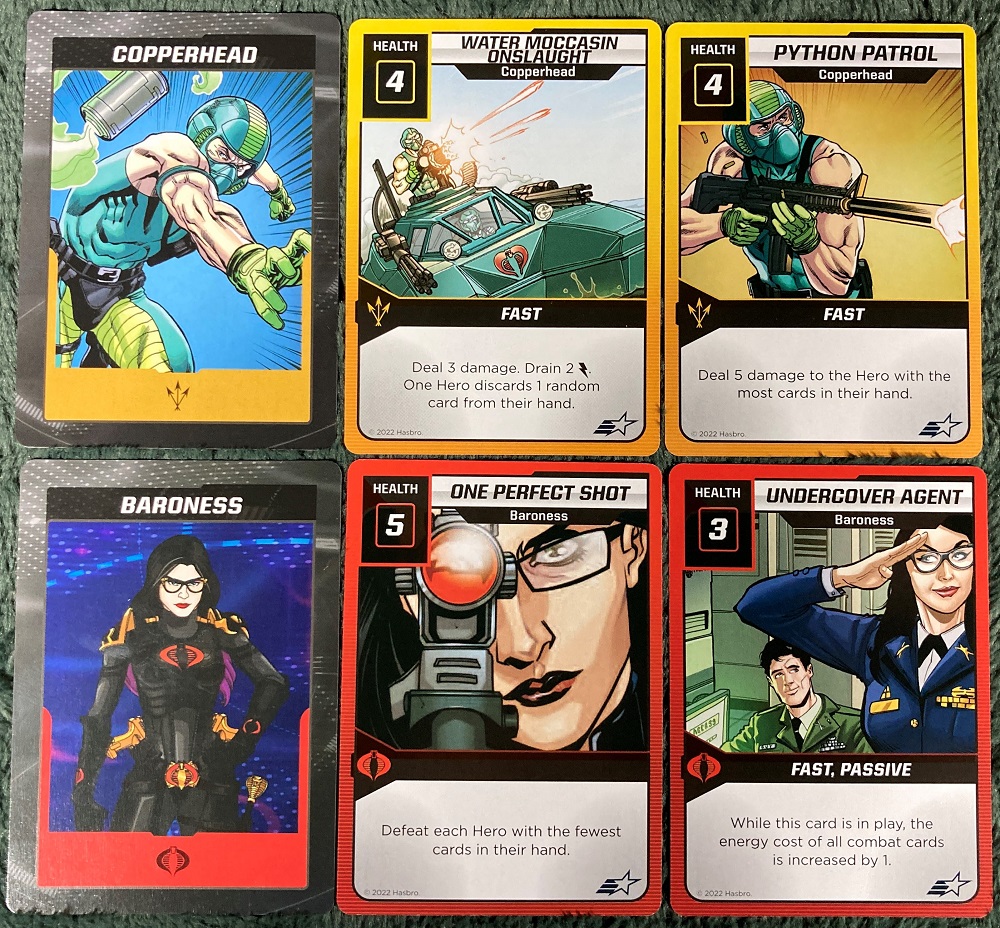
The boss, nemesis, and each of the lieutenants have their own deck of enemy cards which are used to attack during a battle. Each of these enemies has unique cards that reflect their character’s abilities and personality.

The five location boards form the map for the game. The GI Joe headquarters called The Pit is located in the center and surrounded by four different locations. Each of the location boards are double sided and have one side for more advanced players with effects that take place at those locations.
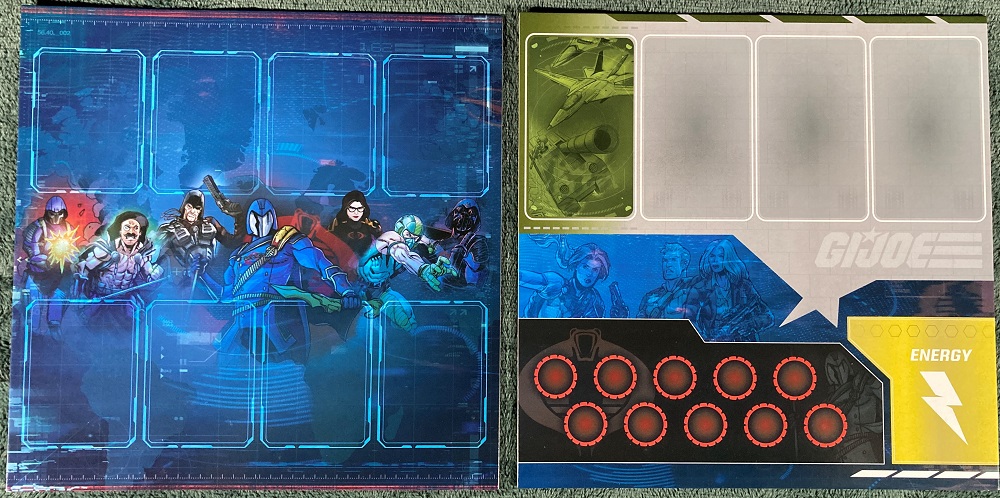
In addition to the map, there are also two boards used during the game. The battle board is used during battles to keep track of enemy cards. The power board holds the Joes’ vehicles as well as captured Cobra foot soldiers which are used to activate the vehicles. There is also a space to place energy tokens for use during a battle.
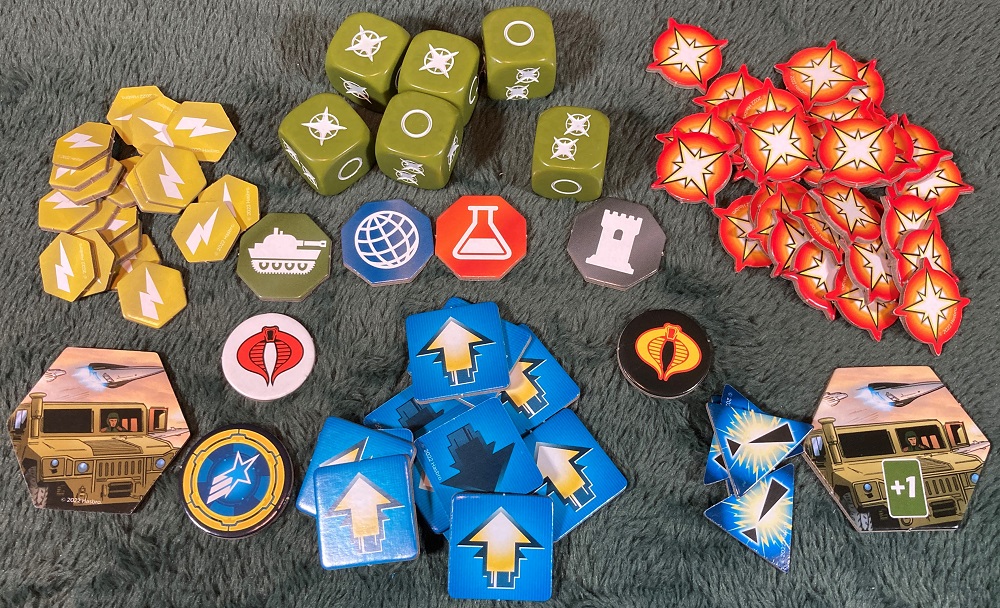
The game also includes a variety of tokens to represent damage, energy, actions, and so forth. There are also six custom combat dice for use during battles.
How to Play G.I. JOE: Mission Critical
The Goal
The goal of the game is to defeat the boss, Cobra Commander.
Setup
NOTE: This setup is based on a 5-player game. There are some adjustments when playing with 2, 3 or 4 players.
To begin, each player chooses a hero to play and takes the corresponding Joe figure, character card, and that characters 10 combat cards. Each player also takes an energy token and two action tokens. Players shuffle their combat cards to form their combat deck and place it face down in their play area with room for a discard pile. Each player then draws as many cards as they wish, up to five maximum, to form their combat hand.
Next create the game board by placing the command center tile in the center of the playing area. Place all of the Joe figures in play on this space as well as 3 energy tokens. Randomly pace the four location boards around the command center. Now randomly place one of the location tokens on each location board. Near the game board form a supply with the combat dice, hit tokens, panic tokens, energy tokens, and lead hero token. Place the battle board nearby so that all players can see it. Set the power board within view of all the players and place the bonus vehicle token nearby. Shuffle the vehicle cards and place them face down on the first space of the power board. Then draw three vehicle cards and place them face up in the other three spaces.
Create a deployment deck by shuffling the universal deployment cards and dividing them into four piles of five cards each. Shuffle a random lieutenant card face down into the second pile and another into the third pile. Finally shuffle the boss card into the fourth pile. Then stack the piles in order with the first pile on top and the fourth pile on the bottom to form the deployment deck. Do not shuffle it! Now create two foot soldier decks, Cobra Trooper and Crimson Guard, and place the matching miniatures next to each deck. Finally, assign a deployment token at random to each set of foot soldiers. You are now ready to start playing.

Gameplay
G.I. JOE: Mission Critical is played in a series of rounds which consist of two phases: the deployment phase and the action phase. Let’s take a look at each.
Deployment Phase
This is the phase when enemies are placed on the gameboard. During each phase, there are always five deployments. For each deployment, flip over the top card of the deployment deck. It will show a number of symbols matching the deployment tokens next to the foot soldier decks. Collect that number of matching foot soldier figures and place them on the location board with the same location symbol as that of the card that is currently on top of the deployment deck. So the card you drew tells you how many and what type of foot soldier and the next card tells you where to put them. Flip over the card that you used for the location to now use it for the deployment symbols and the next card on top of the deck for the location. Do this a total of five times. If a lieutenant, nemesis, or boss card is revealed, you flip it over and add that enemy to the foot soldiers and then place them all on the location of the following card. Lieutenant, nemesis, or boss deployment cards care returned to the box when revealed. The remaining drawn deployment cards are shuffled and then placed at the bottom of the deployment deck.
Each location has a number on it. This is the maximum number of enemy figures can be on it. Once that number has been reached, place a panic token on that location and place any remaining figures into the next location going clockwise around the center. If a lieutenant, nemesis, or boss is to be placed in a location that is already panicked, the place it in the next non-panicked location. These figures always panic a location, even if the maximum number of figures is not reached. If at the end of the deployment phase, all four locations are panicked, then remove all of the energy tokens from the command center. If there are none remaining, the Joes lose the game.
Action Phase
The action phase is where the players spend their action tokens. There is no defined play order, so the players can play their actions whenever they want. To spend an action, a player flips over one of their action tokens and can then either move, battle or recover. You can even perform the same action more than once. When all players have used all of the action tokens they desire, the phase is completed and the players flip their action tokens face up before starting the next round. Now lets take a look at each of the three types of actions.
A move action lets you move your figure to any other location. Distance does not matter. If you move to The Pit in the center, you can power up as part of your move action. If you do not already have a energy token, take one from the supply. Then shuffle all of the cards in your hand and discard into your deck and draw a new hand of up to five cards.
When you do the recover action, you can choose cards from your discard pile with a total of up to 6 shields on then and shuffle them back into your deck. You can also take 1 energy token from the supply if you do not already have one. Recover is good for getting energy and restoring cards to your deck without having to move to The Pit and back. However, if you have so many cards in your discard pile that you need to recover twice, you might as well move to The Pit and power up, then move back to where you need to go. Both situations take two actions.
Battles
Battles are more involved than the other actions. When a player initiates a battle, all Joes and enemies present will take part in the battle. Therefore, make sure all of the Joes you want are there when you start a battle. Only one player needs to spend an action to start a battle, no matter how many Joes will be involved. There are four main steps to resolving a battle. First take 2 energy tokens from the supply and place them on the corner of the power board with the energy symbols on it. All players participating in the battle than add any energy tokens they have to the power board to form the shared energy pool. Now any players with less than five cards in their hand may draw up to five cards. They can draw the cards one at a time and do not have to draw up to five cards. Since the cards remaining in your deck are used for defense, be sure to leave some in your deck.
Next you prepare the enemy. Count the number of foot soldiers in the current location. For each one, draw one enemy card from the matching enemy deck. Place each one as you draw it face up on the spaces of the bottom row of the battle board. If there are more than four foot soldiers, you select which four will be in the battle. If cards have the Fast keyword, place them at the left end of the row. If a lieutenant, nemesis, or boss, their unique deck of enemy cards and draw four cards from it, placing them across the top row of the battle board, placing any fast cards to the left.

Once the battle board is prepared, the players and the enemy take alternating turns. If the enemy has a fast card in play, the one fast card that is on the left most of the top row, or if none there, then the left most of the bottom row, resolves first. Otherwise, the Joes go first. During a player turn, the team chooses one Joe to be the active character and they play one of the combat cards from their hand, paying the energy cost from the shared energy pool. They then resolve the effect. If the card is an attack, the player chooses a target and rolls the dice. each hit result is then applied to that enemy card with hit tokens. If the hit tokens equal or exceed the health of that enemy card, the enemy card is defeated and flipped face down on the battle board. If it was a foot soldier enemy card, take a matching foot soldier figure from that location board and place it on one of the empty red circles on the power board. During an enemy turn, resolve one enemy card, starting with the top left row and then working left to right. Once a card is resolved, rotate it 90 degrees. If a card has already been defeated, it is not skipped, but rotated and acts as the enemy’s turn. After the enemy has had their last turn, the players get one final turn and then the battle is over.
Vehicles can can give the Joes some extra abilities. At the start of a battle, the players have access to the three vehicles face up across the top of the power board. Vehicles can be used as listed on their cards and they do not count as a player turn. In order to activate a vehicle, pay the cost by spending the defeated foot soldier figures on the power board. These are returned to the supply. Once a vehicle has been used, place its card face up in a discard pile. New vehicles from the deck are not placed out in the empty slots until after the battle is over.

When an enemy inflicts damage to a Joe, that player draws a card from their deck and looks at the shields at the bottom. If the number of shields exceeds the damage, then that combat card is placed on the bottom of the deck face down. If the number is equal to the damage dealt, then that combat card is discarded. Finally, if the number of shields is less than the damage, discard that card and subtract the number of shields from the damage and draw another card. Continue this until the number of shields is equal to or greater than the remaining damage. If a Joe ever has zero cards left in their deck, they are defeated. Remove one energy token from the command center. If there are none left, the players lose. Move the defeated Joe’s figure from the battle and place it at the command center. Shuffle all of that Joe’s combat cards together to form a new deck and the draw up to five cards to form a hand. The Joe also gets one energy token. Essentially that Joe is returning to The Pit to power up.
It is now time to cleanup the battle. If there are any energy tokens remaining in the pool, they can be distributed to the players that took part in the battle. Remember, each Joe can only have one energy token at a time. Excess tokens are returned to the supply. All foot soldier cards, whether defeated or not, are shuffled back into their respective decks. In the case of a lieutenant, nemesis, or boss, the defeated cards are placed face up in a discard pile while the rest are shuffled back into their deck. If a lieutenant or nemesis has four cards in their discard pile, they are defeated. Remove their figure and any remaining foot soldiers from that location and return them to the supply. The foot soldiers are not defeated so they do not go on the power board. You also get the bonus vehicle token for defeating a lieutenant or nemesis. In order to defeat the boss, the players must have defeated six of the boss’s enemy cards. This will take more than one battle to do this.
Game End
The game can end in a few different ways. If the players defeat the boss, they win. However, if a Joe is defeated and there are no more energy tokens at the command center, then the players lose. They also lose if at the end of the deployment phase, all four locations are panicked and their are no energy tokens at the command center.
Why You Should Play G.I. JOE: Mission Critical
I have enjoyed playing G.I. JOE: Mission Critical. While the game board may seem simple, with just four locations and the command center in the middle, the meat of the game is in the cards which are used for battle. In fact, battles are where most of the game time is spent. There is also a sense of urgency throughout the entire game as a result of five enemy deployments every round. Even on the first round, there is almost always one location in panic and lieutenants show up in rounds 2 and 3 with the boss coming during the fourth round. Therefore, right from the start, the players have to go on the offensive and try to clear out as many enemies as possible. There is no easing into this game and preparing for future rounds. Your Joes have to hit the ground running and not stop until the boss is defeated.
Unlike deck building games where players start with similar weak starting decks and then acquire more powerful cards over the course of the game, G.I. JOE: Mission Critical features an elegant card system where a player’s cards provide not only actions they can take during a battle, but also as their defense against attacks. Each character has only ten cards, so there is a need to balance using cards for actions while keeping some in reserve. Running out of cards during a battle is a quick way to lose the game if it happens more than a couple times. I really like how each of the combat card decks are customized for each of the five Joes in the game. This not only helps players feel like they are actually that character with their abilities and specialties, it also forces players to play so that the entire team benefits from their abilities. For example, Duke focuses on helping other players attack. He has cards that let other players re-roll dice during an attack. I like to play his Real American Hero card early during a battle. It costs 3 energy, but it lets Duke attack with 5 dice. Plus, any Joe that attacks during that same battle gets to add two additional dice to their attack roll. that can make those attack cards with only two or three dice much more effective. Scarlett’s cards allow players to manipulate the cards in their hand, deck, and discard pile so they can prepare for attacking or defending. Stalker has several cards that focus on defense, allowing him to inflict damage while he is taking it. Snake Eyes has attack cards that allow him to attack more than once during his turn and Cover Girl’s cards focus on using vehicles. Since there is no set turn order during a battle, the players can plan how they want to proceed so they can maximize their potential. This is truly a cooperative game where the players really benefit from working together.
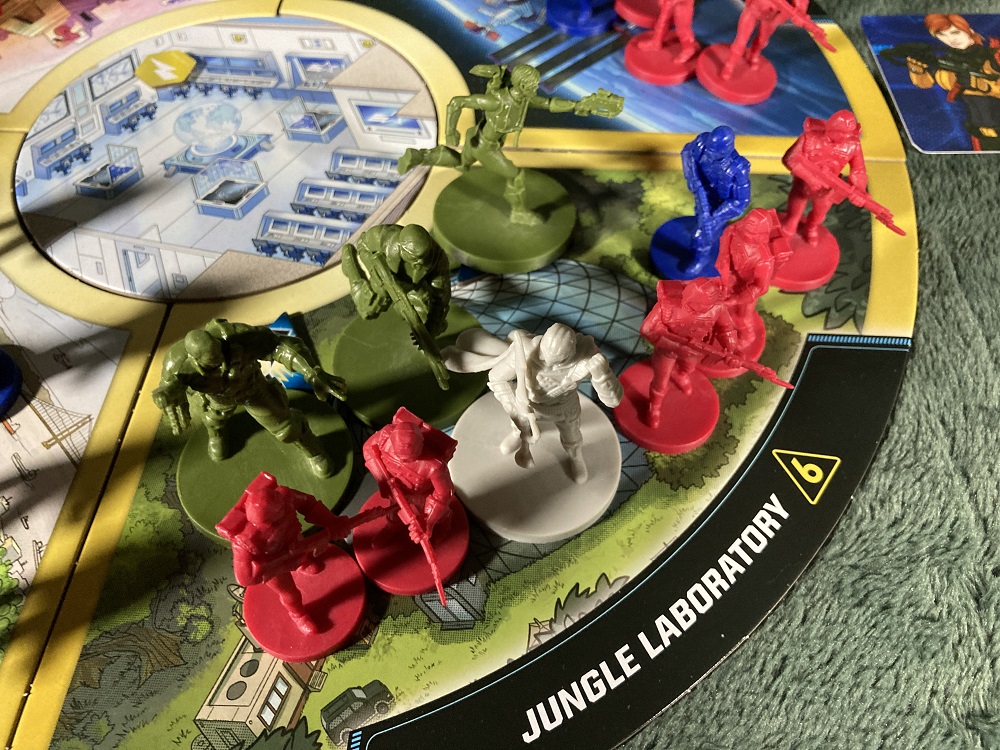
Just like the Joes each have different specialties, so do the lieutenants, the nemesis, and the boss. Combined with the foot soldiers, the enemy cards can create a dynamic battle. Some enemy cards inflict damage. There is no die rolling for enemies. You just get the damage listed on the card. Other enemy cards steal away your energy, which can be just as crucial since your more powerful cards cost energy. Since all the cards are laid out at the start of the battle, the players can see what they face and then determine their priorities. If you can defeat an enemy card before it activates, then you do not suffer any negative effects when it is supposed to activate. In fact, that enemy turn is essentially skipped. Once again, the game forces players to cooperate in order to achieve victory.
While I am very impressed with G.I. JOE: Mission Critical, the only downside to the game is the game manual. Even after I read it and thought I understood everything, I found myself having to refer back to it during a game and since some topics are covered in two or three places, but not all the information is in each place, I found myself not following all the rules during my first playthrough. However, once I had played it, and then went back to read the rules again, it made more sense. Although the rulebook could be improved, and may make the game a bit more difficult for the first playthrough or two, the rules, mechanics, and gameplay are solid. It is also important to note that the rules are written for five players. Towards the end of the rulebook, there is a section detailing the changes if you are playing with 2, 3, or 4 players. Each player count has differences. Yet, though this can be confusing at first, I found these changes to be great for keeping the game balanced no matter how many people are playing. For example, in a 3-player game, each character gets 4 action tokens rather than 2. But you only get 2 energy tokens at the command center, so you have to be more careful about your Joes being defeated in battle.
As I mentioned earlier, I have a lot of fun playing G.I. JOE: Mission Critical. Since one of the things I like is the different abilities of the Joes as well as the enemies, I am excited to try out some of the expansions to the game. The Heavy Firepower expansion is available now and adds three new Joes (Roadblock, Bombstrike, and Gung-Ho) as well as Cobra lieutenant Scrap-iron and new boss Destro. It also comes with three new vehicles. A second expansion was recently announced as well. Chaos Break will be released later this year and add two new Joes, Beach Head and Ripcord, and two new vehicles as well as Zartan as a new boss and two lieutenants: Zarana & Road Pig. I recommend G.I. JOE: Mission Critical for those who are fans of G.I. JOE as well as cooperative strategy games.
For more information, visit the G.I. JOE: Mission Critical webpage!
Click here to see all our tabletop game reviews.
![]() To subscribe to GeekDad’s tabletop gaming coverage, please copy this link and add it to your RSS reader.
To subscribe to GeekDad’s tabletop gaming coverage, please copy this link and add it to your RSS reader.
Disclosure: GeekDad received a copy of this game for review purposes.
